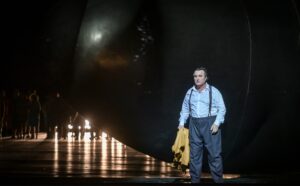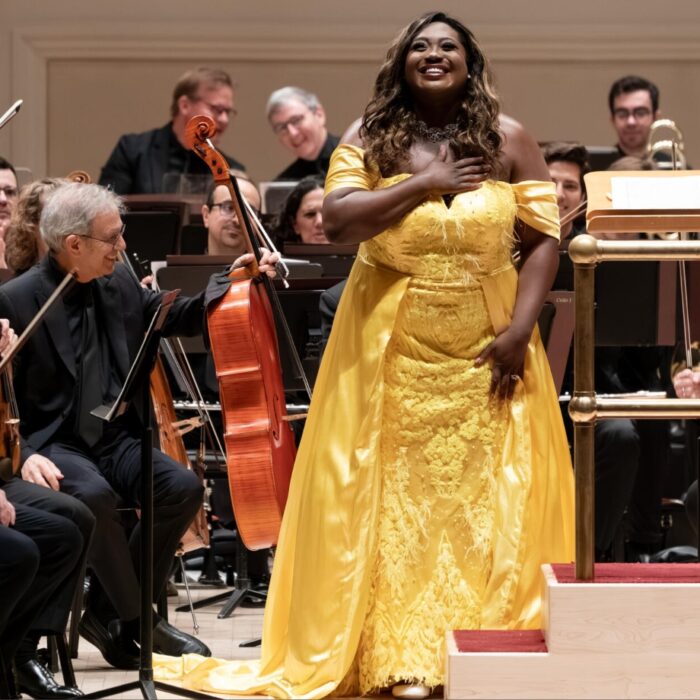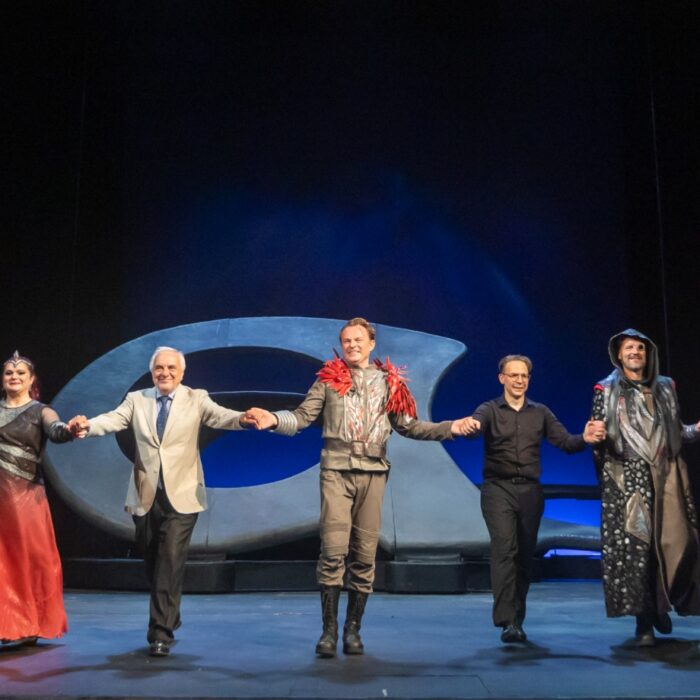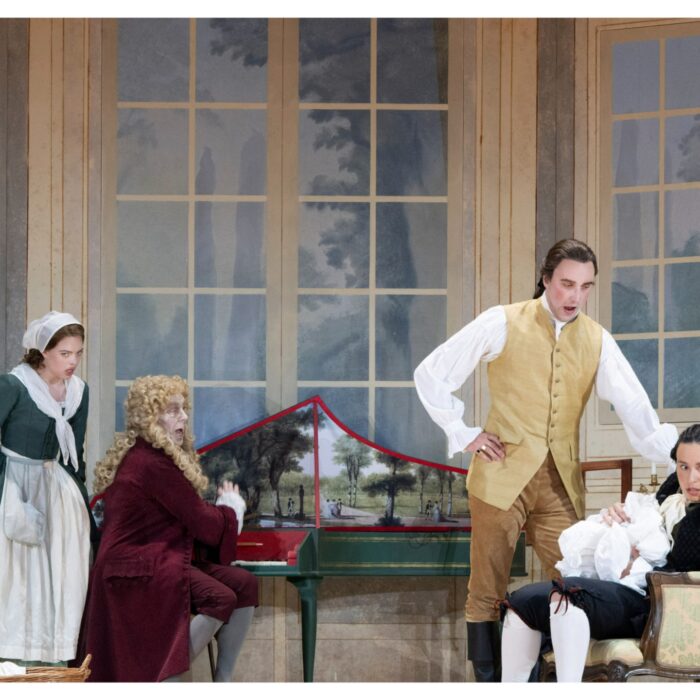
Opéra de Paris 2024 Review: Simon Boccanegra
By João Marcos Copertino(Photo credit: Vincent Pontet-OnP)
A few years ago, when Bieito’s staging of “Simon Boccanegra” premiered at the Paris Opera, the reviews were abysmal. Few things are as catchy in the opera world as negative consensus. I got to see the same production with a very similar cast last weekend, and, somehow, I think it was one of the most emotional and revealing operatic experiences of my lifetime. Did something change? Or are my eyes and ears twisted?
Watching Bieito’s production comes as recalibration of my critical apparatus. His stagings are provocative, vulgar, and not unoftenly opaque, but they are seldom uninteresting. And, more often than not, I am glad to see a new dimension of the work through his eyes. In many ways, I become a better operagoer—and a better critic—when I try to understand what has happened in a Bieito staging. It does not mean that I always like his work, but that his work often leads me to think things through more thoroughly.
His “Simon” presents us with a surreal tale of politics and power. Bieito took to heart Simon’s words in the prologue, “È sogno!… Sì; spaventoso, atroce sogno il mio!” (“It is a dream!… Yes; a terrible and atrocious dream of mine!”). As when we go to sleep, the opera starts in perfect silence. The darkness in Bastille forbids even the traditional welcoming applause for the conductor before the start. Simon/Tézier enters the stage as if he were sleeping, the pelagic strings wavering in lullaby until he wakes up in a strange world filled with music.
Because we are in the dream realm, the series of symbolic elements that appear on stage do not “translate” the plot of the opera so much as offer puzzle pieces of a psyche. We, the audience, are invited to contemplate these loosely assembled pieces and to admire them in their strikingness. As in a dream, the symbols are better explained in analysis (after the dream). In the theater, we ought just to live it with the cast—and I was mesmerized.
One of the most insightful negative reviews of Bieito’s original run of “Simon” claimed that the production was marred by a drama whose logic seemed motivated purely by its striving for an aesthetic experience. “It was like Zeffirelli,” Clément Taillia wrote, “but ugly.” In many ways, Taillia is not wrong, but I think he missed the importance of the orchestra as a dramatic character in Bieito’s staging. Indeed, Bieito’s shocking aesthetics seem aloof from the drama-making itself. It is as if the stage becomes a kaleidoscopic juxtaposition of images. The rotating ship that makes up all the staging works solely to redirect familiar elements.
Bieito is no Zeffirelli—for better or worse—but, as was the case with the gifted disciple of Visconti, the predominance of visual effects in Bieito seems to reveal an unexamined premise of the criticism: just what are the horrible crimes against theater that are committed when the visual stage is the main driver of amusement? Why are we so afraid of aesthetics over drama? Is not that the drama cannot be seen through the aesthetics after all—otherwise all baroque painting would be doomed.
In the case of Zeffirelli, the lush spectacles, and the monumentalizing image he has come to take on for us, sometimes even seem to make the musical performances themselves superfluous: how many less-than-optimal casts have we seen in more-than-pleasurable productions of his Met Opera “La Bohème”?
But, here, with Bieito, the impressive aesthetics seem to work differently. Unlike Zeffirelli, where visual beauty can stand on its own, Bieito’s provocative stagings work only when accompanied by the most exquisite musical performances, as if the impressive images that we see can be understood solely in their ambivalent relationship to a singing that is more than beautiful. Musical enchantment is leavened and made ambivalent by the visual lewdness.
In the case of this “Simon,” the singing was extraordinary—making the staging extremely interesting. I have read great things about the musical performances in the 2018-19 run of the opera, but I dare to say that this time—especially because of a very thoughtful musical direction by Thomas Hengelbrock and the exuberant cast— things were even better.
The ambivalent relationship between great music and shocking aesthetics led to a complete renovation of “Simon.” It is still Simon over the sea, and still the same political plot; it is just deprived of all of the illusionist elements of idyllic Genoa .
Perhaps the most original aspect of Bieito’s staging is his casting of an actress to stay on stage as Maria Fiesco. Her presence on stage is extremely uncomfortable, but it shows a dimension of “Boccanegra’s” music that is often hard to grasp: the opera has beautiful moments, but its finales are always very good at keeping the audience quiet—there are less aria applausi in “Simon” than in “Un Ballo in Maschera,” for example. It is not that “Simon’s” arias and duos are anticlimatic; it just feels wrong to applaud. They call for the continuation of the action. This call derives from a felt aspiration beyond meaning: in “Simon” the orchestra seems to want to say more than can actually be said in a wordless medium. Perhaps such discomfort, the production seems to suggest, can be expressed by Maria Fiesco’s ghost: a spectral element—like the orchestra itself—that seems to carry more meaning than we can actually make sense of.
Maria Fiesco enters the stage while being dragged by her father, in agony until she dies. Mika Kares as Fiesco sings “A te l’estreno addio” placidly, as if it were the most lyrical of all arias. The tormenting image of a father who seems unable to save his daughter—who can even kill her— presents a direct confrontation between musical gorgeousness and terrible visual images. Few times has that aria sounded so beautiful. If it were sung half an inch less perfectly, the whole dramatic experience would be lost, but Kares—like basically everyone in the cast—seems to understand her task. The success of the image lies precisely in the contradiction: Maria’s ghost evokes precisely this dual and contradictory nature in “Simon.”
After that, the opera was filled with unforgettable moments that seemed to reach perfection. The intensity of the drama was such that the audience could not clap—a common circumstance in “Boccanegra.” But here it was aggravated: the transition from the prologue to the first act saw the most sorrowful of Tézier/Simon’s tears over Maria’s body. Perhaps the aesthetic colossus of the night derived from the complex relationship between amazing performances and many reminders that there is something in the air that haunts us. That our pleasure, while great, should also entail some degree of violence and sacrifice is an uncomfortable thing to see.
In such a world, the perfect singing of most of the singers seemed like a dutiful task, as if they knew that their voices would reveal something in the melodrama that would make things worse for them, even as it made things more pleasurable for the audience. Each time they opened their mouths, they seemed to know that their lives would become worse than they were before. The result was that all the arias—all of them—seemed to be invocations of a fully new text, as if, even knowing the text, I could not anticipate what they were going to say. More than arias, they worked as monologues. There was a sense of theater that was like that for which Verdi is well-known, particularly in “Otello” and “Falstaff,” but that also had something that seemed extremely original and modern. After the performance, I thought of “Simon” as if it were in dialogue with “Parsifal,” “Pelléas et Melissande,” and even “Wozzeck”—operas where the characters seem to be able to listen to the orchestral sound. In the context of any other production, such a fancy would be but a hallucination of a philistine critic; in the context of Bieito’s, it feels like a revelation, as if Verdi’s score still had an ocean of secrets to explore.
None of the musical and dramatical success of the night would have been possible without the excellent and generous work of Thomas Hengelbrock. Not so long ago, I witnessed one of his low points in Aix-en-Provence; here in Paris, and I felt the urge to congratulate him ad aeternum. What a musical reading! Beyond the basic competence of not overwhelming the singers’ voices and conducting in synchrony with the staging, his reading sounded extremely slow and careful. He gave time for all the instrumental solos of the Opéra de Paris orchestra to shine as if they were diegetic commentaries on the staging. As in a dream where all the elements presented are part of the experience, Hengelbrock conducted as if all the solo instruments were actually characters on the stage. His slow and patient reading of the score allowed the instruments to pop up as if they were going to say something, almost as if words might be perceived floating out of their smooth sounds. Of course, it was not like Wagner where wordless sounds reflect ineffable elements or situations; part of the compelling atmosphere in Hengelbrock’s reading of “Simon” lies precisely in the frustration in our not being able to access whatever meaning may be there in the orchestra.
When there were words to be said, Hengelbrock’s patient reading allowed the singers to sing carefully, as if the orchestra could not distract them. It was as if the orchestral sounds were listening to what they had to say. Few times in my life have I watched an opera in Paris with more crystalline Italian pronunciation. It felt as if the language of Petrarch could not have been graced with better pronunciation. Tézier himself showcased his “old-school” technique of creating small vowels after each consonantal sound, just to make the word-sound even more evocative. It was a genius night.
Speaking of the star of the night, Ludovic Tézier: perhaps, at first sight, Tézier’s voice—always great—might sound a hair less youthful than before, but his interpretation was beyond great. In a role that requires much more psychological depth than most Verdian characters—especially those derived from romantic Spanish plays, Tézier shone as a beacon of operatic interpretation. His voice has all the vocal qualities of great ones: extremely accurate enunciation, uniformity of all the vocal registers, a latitude of colors, and great technique to make the most thrilling crescendi and pianissimi. In fact, if one closed their eyes and treated his “Simon” as a concert version, they would have almost no grounds for disappointment.
But, beyond his extremely compelling musical performance, Tézier is also an actor of another caliber. It is hard to classify his acting skills in any “acting school.” He has a certain capacity of forging emotions that are both extremely compelling and, because so theatrical, evidently feigned. In this “Simon,” he deployed that skill to perfection. Rarely leaving the stage—after all, the opera is his nightmare. His movements were always convincing, but never grandiloquent, as if he were aware that simply his being himself should be the focus of attention.
In the most anguishing moments of the opera, his personality allowed all the ambiguity in Bieito’s staging to pop up. How could we deal with his populist behavior especially in the end of the first act? Tézier does not sacralize his character; he makes it a tragic complex figure whose likability might not be a factor. We might even disdain his Boccanegra as a character as we would not were he a less complex-minded singer. It is Tézier who lets us be so ambivalent about Boccanegra. It is a masterpiece of character construction. After all, this is but a surreal representation of politics, and dreams, pace common opinion, are neither good nor bad; like all psychic manifestations, they are ambivalent. Their images might reveal both beauty and catastrophe. We see Boccanegra with Daniel’s eyes: Daniel, who, in the Scriptures, interprets Nabucco’s dream of a statue with clay feet. Few singers are as mature and complete as Tézier, nowadays.
The other revelation of the night was Finnish Bass Mika Kares. In his portrayal of Fiesco, we found not only his usual great vocal capacities, but what also might be this generation’s best portrait of the character. I have heard more than a few “Simons” so far, and I could not name any other singer (from this generation or former ones) who does with Fiesco what Kares has done. His voice, generous and solid, might lack some brightness in the high notes—but Fiesco is not a high role! Kares vocally managed to sing his role beautifully but never found obvious solutions. Where most singers would produce mostly a cadaverous voice and collect their paycheck, Kares delivered a solid lyric performance. His voice, naturally loud, sounds lyric and well-phrased with the most beautiful long lines. Both visually and musically, his entrance in “A te l’estreno addio” is the most exuberant thing I have seen in years. As I said before, the impregnating power of the scene is made possible only by the contraposition of the violence with the most beautiful singing. That puts us always in defensive relation to Fiesco, even as we really need to listen more to Kares’s voice. In the opera’s finale, when he proclaims Gabriele the new Doge, it is hard not to feel the bittersweetness of the situation: should we finally give in to Kares’s charm, or does his beautiful singing come at the expense of Simon and Maria’s deaths? Moreover, Kares seems to be a very attentive musical colleague. His voice seemed intentionally in full conversation with the orchestra but also with his castmates. His duo with Tézier in the third act was a masterclass on how singers should always be listening to one other. He actively coordinated his voice to match with Simon on a level that was moving, especially when doing it with impeccable legato.
Nicole Car was, in her usual wonderful fashion, in a state of grace. Her “Come in quest’ora bruna,” perhaps a little bit more strident than her performance the rest of the night, was filled with interesting languidity. The sorrowfulness of Simon’s cries at the end of the prologue seemed still to linger in her voice at dawn. More than a classic ingenue, her Maria/Amelia was a tragic figure. She presented a continuation (even visually) of the ghost of Maria Fiesco, her mother, but also something of an Ophelia floating in the oneiric waters of Simon’s dreams. After she is harassed in the first act, her body and makeup will never lose the traces of the violence committed. She is progressively turning into a ghost of a woman—a premonition of the consequences of the rise to power of her lover Gabriele Adorno. It is hard to enumerate Car’s great moments in the night. Her duo with Tézier in the first act was impeccable. But I think a moment that summarized her performance might be her trill at the end of the first act. With all the chorus there trying to understand her abduction, Car appears and slowly unpacks a trill of notes. Her performance was in the fashion of Hengelbrock’s patient reading, but also showcased her attentiveness and carefulness when singing even the smallest of musical moments. Her voice sounded pure without any vibrato; her presence, her notes sounded like an appeal to hold the tempo, as if the slower she sang, the more possible it would be for Amelia/Maria to control the time. Her life has been too difficult; let her seize at least one moment where things might be a little bit less tragic. In that end of the first act, Nicole Car was almost able to stop the spinning of the earth and time itself.
Charles Castronovo played the congenial character of Gabriele Adorno. His voice, reaching a certain kind of maturity full of darker and harsher tonalities, allows him great expressivity. His intense familiarity with the role shows, especially in his rendition of “Sento avvampar nell’anima.” In the aria, Castronovo sings in conversation with the orchestra, unlike most tenors, who sing it as a lyrical battle against it. His voice, powerful on its own, works as a central device to bring a certain interiority to the character that is often missed if the tenor is too concerned with stressing its strength and power. It was a brilliant performance, but not a narcissistic one, serving as it did the drama. So, when he sang about Amelia/Maria’s “virtù,” right in front of Maria Fiesco’s ghost, his voice did not seem to be showing off a tenor’s power potent, but seemed rather to be a dramatic ascertainment of the fate entailed by staking a claim for power. His registers, very uniform, simply expanded the intellectual approach of his role.
In the major cast, finally, we have the presence of the always competent Étienne Dupuis. Paolo is a dramatically daunting role, but not particularly challenging vocally. Dupuis sang it with ease. Right in the beginning of the prologue, how can we not side with him for a brief moment when he shows his true colors: “Aborriti patrizi, Alle cime ove alberga il vostro orgoglio, Disprezzato plebeo, salire io voglio” (“Abhorred patricians, To the heights where your pride dwells, Despised commoner, I will ascend.”). The only problem is: can a singer as sophisticated as Dupuis ever convince us in this day and age that he is a commoner?
Alejandro Baliñas Vieites as Pietro is also well cast. The voice of this singer from Paris Opera Atelier seems to be growing more and more into the bass repertoire.
Usually, I tend to believe that the word “perfection” cannot be applied to opera performances. Films, pre-shot and edited, can be perfect; performances cannot. Part of the contingency of attending a theatrical performance is that imperfection will be everywhere to be seen—even in the most refined productions. An operagoer learns to love precisely this natural imprecision and to cherish it when things go extremely well. I do not know if a few years ago the performance was as good as this one. I am tempted to believe that Bieito’s staging might have lost most of its appeal in the hands of another conductor or of a cast less dramatically and vocally engaged. But what I found in this run of “Simon Boccanegra” was almost ideal: a strongly emotional experience that, if watched with an open heart, can forever change the way one looks at what might be Verdi’s most underrated dramatical colossus. It might not have been perfect, but sometimes it felt as if it were but a few steps from it.


